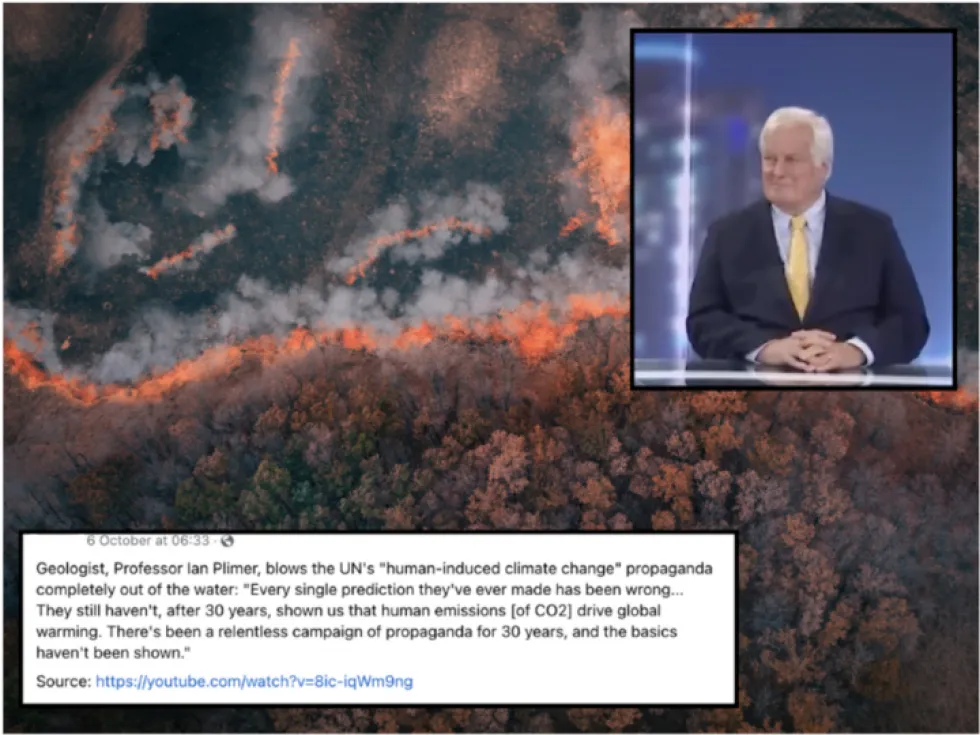By: Soham Shah
November 13 2023
 A video viral on Facebook shows geologist Ian Plimer denying climate change. (Source: Adobe Images/Facebook/Modified by Logically Facts)
A video viral on Facebook shows geologist Ian Plimer denying climate change. (Source: Adobe Images/Facebook/Modified by Logically Facts)
In a video uploaded on Facebook on October 6, 2023, an Australian geologist named Ian Plimer, known for spreading climate misinformation, makes various misleading claims about climate change. From the logos seen in the Facebook video, the clip appears to be from the
"Rita Panahi Show" on Sky News Australia. The Facebook post also includes a link to a YouTube video titled, "Green policies promulgated by the UN is killing people': Ian Plimer," which was uploaded to Sky News Australia's YouTube channel on March 24, 2023, from which the viral video has been extracted.
The Facebook post in question has around 1,300 shares and over 2,000 reactions. The claims involve the frequency of hurricanes and wildfires, increase in sea levels, climate-related deaths, and climate predictions.
Facebook post in which Ian Plimer makes various misleading claims about climate change (Source: Facebook/Modified by Logically Facts)
The National Aeronautics and Space Administration (NASA) and the Intergovernmental Panel on Climate Change (IPCC) clearly state scientific consensus on human activity being the primary cause of increased greenhouse gas concentrations driving global warming since the middle of the 20th century.
A research paper published in the journal Environmental Research Letters in 2021 concludes, with high statistical confidence, that “the scientific consensus on human-caused contemporary climate change—expressed as a proportion of the total publications—exceeds 99% in the peer-reviewed scientific literature.”
We take a look here at the various claims made in the Facebook post.
According to NASA, the global frequency of storms may remain the same or decrease, but global climate models predict hurricanes are likely to cause more intense rainfall and have an increased coastal flood risk due to higher storm surges caused by rising seas. National Oceanic and Atmospheric Administration (NOAA) climate scientist Tom Knutson says that models show increases in hurricane rainfall rates by the year 2100.
Professor Rajib Maity, who studies hydroclimatology at the Indian Institute of Technology, Bombay, told Logically Facts, "Changes are now being realized through several extreme hydrological and weather events, particularly in the recent past (~10 years). Now, rather than overall number or magnitude, it is mainly about spatial/temporal re-distribution of several phenomena, including sea level rise." This, he says, means that hurricanes are more prone to intensify in power and wreaking havoc.
According to the United States Environmental Protection Agency, even though the absolute sea level has decreased in some places, the absolute sea level has increased steadily overall.
According to Climate.gov by the National Oceanic and Atmospheric Administration (NOAA), a scientific and regulatory agency within the United States Department of Commerce, the global average sea level has risen 8–9 inches (21–24 centimeters) since 1880. The global average sea level also hit a record of 101.2 mm (4 inches) above 1993 levels in 2022.
Seasonal (3-month) sea level estimates from Church and White (2011) (light blue line) and University of Hawaii Fast Delivery sea level data (dark blue). The values are shown as change in sea level in millimeters compared to the 1993-2008 average. NOAA Climate.gov image based on analysis and data from Philip Thompson, University of Hawaii Sea Level Center. (Source: Climate.gov)
NOAA Climate.gov based on data provided by Philip Thompson, University of Hawaii (Source: Climate.gov)
In an interview with The Royal Society, Professors Stefan Doerr and Dr. Cristina Santín from Swansea University explained how their research showed that globally, the area burned due to wildfires has decreased. This decrease is mostly driven by the savannas of Africa, South America, and Australia due to land being converted to farmlands and shifting rainfall patterns.
They also highlighted that burn areas in regions like the western parts of North America are increasing and rejected the proposition that this shows climate change is not affecting wildfires.
A 2006 study in the journal Science titled "Warming and earlier spring increase western U.S. forest wildfire activity" records increases in the frequency, duration, and seasons of wildfires due to climate change in North America in the 1980s.
According to the World Meteorological Organization (WMO), there has been an increase in weather-related disasters over the past 50 years, which has caused more damage but fewer deaths. WMO Secretary-General Prof. Petteri Taalas explained that even though increased exposure has led to greater economic loss, "Improved multi-hazard early warning systems have led to a significant reduction in mortality."
A BBC report from May 22, 2023, titled "Why is extreme weather killing fewer people?" stated that 'better early warning systems and disaster management in developing countries mean fewer people are dying.' The report added that lower death tolls have nothing to do with such events becoming less frequent or severe.
An article in Carbon Brief by climate scientist Zeke Hausfather, based on his research paper published in the journal "Geophysical Research Letters" comparing various popular climate models from 1975 to 2013, concludes, "Climate models published since 1973 have generally been quite skillful in projecting future warming. While some were too low and some too high, they all show outcomes reasonably close to what has actually occurred."
"The results of this study of past climate models bolster scientists' confidence that both they as well as today's more advanced climate models are skillfully projecting global warming," study co-author Gavin Schmidt, director of NASA's Goddard Institute of Space Studies in New York, was quoted as saying in an article published by NASA on January 9, 2020.
Plimer has made various statements in the video to claim that climate change is not real, whereas greater scientific consensus points to human activities being primarily responsible for climate change. While Plimer's claims are not entirely false, they lack important context and can mislead audiences.